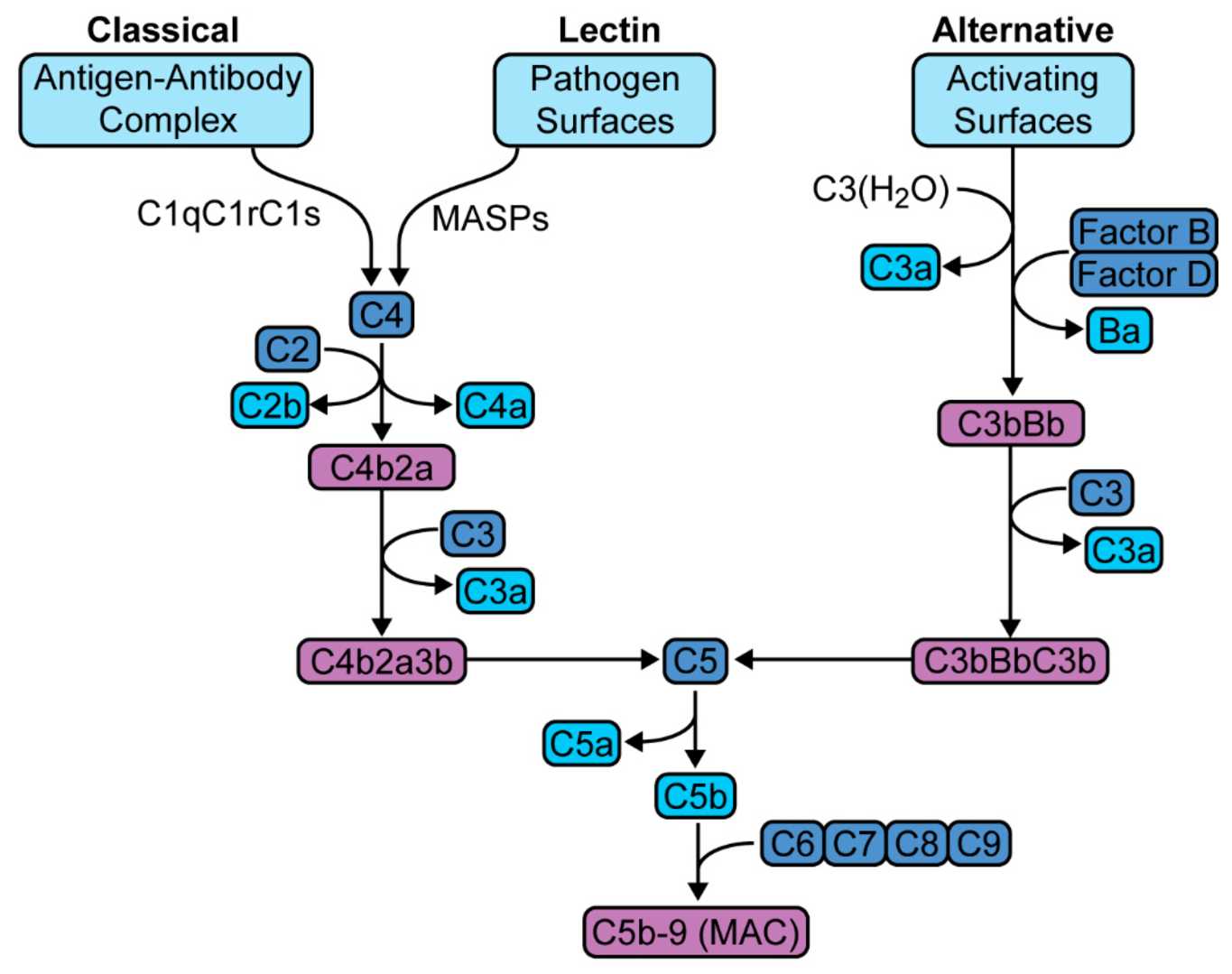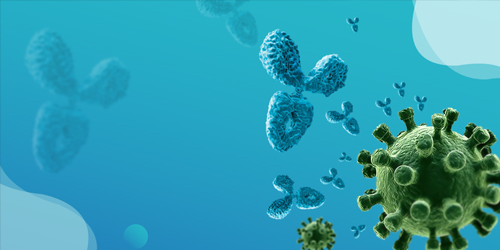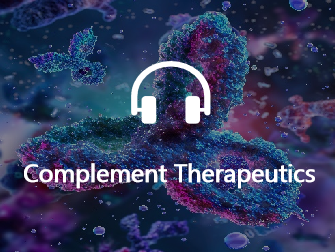Complement Overview Complement Activation Pathways Complement Function Complement Regulation Effector Functions Complement in Diseases Resources
Complement System Overview
The complement system immunology bridges innate and adaptive immunity. This network of proteins orchestrates
critical complement immune responses, ensuring protection against pathogens and maintaining host homeostasis.
The complement network is a complex collection of more than 30 soluble and membrane-bound proteins. They work in
concert to seek out, opsonise and destroy pathogens. As an underlying mechanism, immune system complement can be
used to support the performance of antibodies and phagocytic cells.
The complement immune system in immunology is a fast-response system that kills pathogens directly by forming a hole
in their membranes. Complement proteins are precisely programmed to prevent injury to host tissue, highlighting the
precision of this immune protection.
Historical Background of the Complement System
The complement system was identified only in the late 19th century by Jules Bordet, and its function involved
antibody-based bacterial lysis. In the subsequent decades, decades of research revealed the importance of complement
immunity and revolutionised how we thought about host-pathogen interactions.
-
1890s: Birth of heat-resistant serum factor, aka "complement".
-
1960s: Discussion of the three activation routes (classical, alternative and lectin).
-
The Current Era: Advances in complement technology, leading to therapeutic
applications targeting complement dysregulation in diseases such as paroxysmal nocturnal hemoglobinuria (PNH)
and age-related macular degeneration (AMD).
Biopharmacological Application of the Complement System
The immune complement system is the anti-microbe first line of defence. Profound functions: opsonisation,
chemotaxis, direct lysis. The complement system in immunity connects the two arms of the immune response:
-
Innate immunity: Antigen recognition and elimination at a speed.
-
Adaptive immunity: B cell activation and antibody generation are enhanced.
A new generation of studies has identified the complement system as being responsible for tissue homeostasis,
apoptotic cell clearance and inflammation control.
Major Pathways of Complement Activation

Fig. 1 Complement activation pathways and assembly of the terminal pathway.1, 2
There are three primary pathways through which the complement system is activated:
Table. 1 Three primary ways in which the complement system is activated.
|
Pathway
|
Trigger
|
Key Component
|
Mechanism
|
|
Classical Pathway
|
Activation occurs when antibodies (IgG or IgM) bind to antigens, forming immune complexes.
|
C1 complex (C1q, C1r, C1s)
|
-
C1q binds to the Fc region of the antibody.
-
C1r and C1s are sequentially activated, leading to cleavage of C4 and C2.
-
This generates the C3 convertase, which amplifies the cascade.
|
|
Lectin Pathway
|
Activation is initiated by pattern recognition molecules such as mannose-binding lectin (MBL) or
ficolins binding to pathogen-associated molecular patterns (PAMPs).
|
MBL-associated serine proteases (MASPs)
|
-
MASPs cleave C4 and C2, forming the C3 convertase.
-
This pathway is antibody-independent, making it a critical part of innate immunity.
|
|
Alternative Pathway
|
Spontaneous hydrolysis of C3 or direct interaction with pathogen surfaces.
|
Factor B
Factor D
Properdin
|
-
C3 undergoes spontaneous hydrolysis to form C3(H2O).
-
Factor B binds to hydrolyzed C3, and Factor D cleaves Factor B to generate a fluid-phase C3
convertase.
-
Properdin stabilizes the convertase, amplifying complement activation.
|
Common Pathway and Terminal Activation
All three pathways converge at the cleavage of C3, leading to:
-
Formation of the C5 convertase.
-
Activation of the Membrane Attack Complex (MAC), which creates pores in the target cell membrane, resulting in
lysis.
Core Functions of the Complement System
The activated complement system does this by means of a series of proteolytic steps that initiate effector
molecules. There are three main kinds of functions.
Pathogen Surface
C3b Binding
Recognition by Phagocytes
Pathogen Engulfment
Formation of MAC
The immune complexes are cleared by the complement system. C3b attaches to these complexes, which they then dissolve
and clear from the spleen and liver.
Table. 2 Key roles in immune complex handling.
|
Step
|
Molecule Involved
|
Outcome
|
|
Immune complex binding
|
C3b
|
Solubilization of immune complexes
|
|
Transport to phagocytes
|
CR1
|
Clearance via liver and spleen
|
-
Regulation of Inflammatory Response
Complement fragments (e.g., C3a, C5a) act as
anaphylatoxins, inducing:
-
Vasodilation.
-
Increased vascular permeability.
-
Recruitment of immune cells to the site of infection.
Stimulus
C3a/C5a Release
Mast Cell Activation
Histamine Release
Inflammation
Regulation of Complement System
The complement system's regulation involves several key players and mechanisms, which ensure precise control of
activation and termination.
Soluble Regulators
Table. 3 Soluble regulators of complement system.
|
Regulator
|
Function
|
Pathway Targeted
|
|
C1 Inhibitor
|
Inhibits C1r and C1s, preventing activation of the classical pathway
|
Classical Pathway
|
|
Factor H
|
Promotes C3b inactivation by factor I; prevents alternative pathway amplification
|
Alternative Pathway
|
|
Factor I
|
Cleaves C3b and C4b to inactive fragments in the presence of cofactors
|
All Pathways
|
|
C4-binding Protein (C4BP)
|
Accelerates decay of C3 convertase in the classical and lectin pathways
|
Classical and Lectin Pathways
|
|
Vitronectin
|
Prevents MAC formation by inhibiting C5b-7 complex integration
|
Terminal Pathway
|
Membrane-Bound Regulators
Table. 4 Membrane-bound regulators of complement system.
Complement receptors on immune cells also play a regulatory role. For example:
-
CR1 (CD35): Seen on erythrocytes, leukocytes and phagocytes; assists with the
removal of immune complexes and suppresses overactivation.
-
CR3 (CD11b/CD18): Enables phagocytosis and suppresses complement-induced
inflammation.
Dysregulation and Associated Disorders
The complement deficiency can lead to pathological conditions.
Effector Functions of the Complement System
Complement activation, regardless of the pathway, converges on the generation of three broad effector pathways that
serve to enable the complement to fulfill its physiological imperatives in host defense.
A primary opsonin called C3b adheres to microbe surfaces and labels organisms for phagocytosis by immune cells,
including macrophages and neutrophils. This is an activity that bridges innate and adaptive immunity through
improved antigen presentation.
-
Chemotaxis and Inflammation
Anaphylatoxins (C3a, C5a) are chemoattractants that attract immune cells to the point of infection. Degranulation of
mast cells and basophils by such fragments also encourages inflammation.
The terminal pathway culminates in the assembly of MAC (C5b-C9), which forms transmembrane pores, leading to osmotic
lysis of targeted cells. This is particularly effective against Gram-negative bacteria.
Table. 5 Effector functions of complement fragments.
|
Fragment
|
Effector Function
|
|
C3b
|
Opsonization, immune complex clearance
|
|
C3a
|
Anaphylatoxin, induces inflammation
|
|
C5a
|
Strong anaphylatoxin, chemotaxis
|
|
MAC (C5b-C9)
|
Membrane attack and cytolysis
|
Complement Functions and Diseases
Even though we know that complement protects, the breakdown of the complement system leads to everything from
autoimmune disease and infectious disease to cancer.
-
Autoimmune disease results from a peculiar immune response to antigens of the self. Complement dysregulation can
make these conditions even worse by being activated too strongly or overregulated.
-
Complement proteins have dual roles in infections and malignancies, acting as both defenders and facilitators of
disease.
Table. 6 Complement roles in disease categories.
|
Disease Category
|
Complement Mechanism
|
Example
|
|
Autoimmune Diseases
|
Aberrant activation and immune complex buildup
|
SLE, RA
|
|
Infectious Diseases
|
Pathogen evasion of complement attack
|
Neisseria meningitidis
|
|
Cancer
|
Immunosuppression via complement regulators
|
Breast, lung cancer
|
The close relationship between the complement system and disease highlights its dual nature as a guardian and
potential adversary of human health. Advances in therapeutic targeting (especially monoclonal antibodies and small molecule inhibitors) have opened up new
opportunities for precision medicine. In addition, the development of robust assays for complement activity can help
to better study complement-related diseases.
Complement components and split products are invaluable for disease researches. We offer complement testing
services, including:
If additional help is needed, please directly contact us and consult our technical supports for more detail.
Resources
References
-
Ng, Nicole, and Charles A. Powell. "Targeting the complement cascade in the pathophysiology of COVID-19
disease." Journal of Clinical Medicine 10.10 (2021): 2188.
-
under Open Access license CC BY 4.0, without modification
For Research Use Only.
Related Sections:




